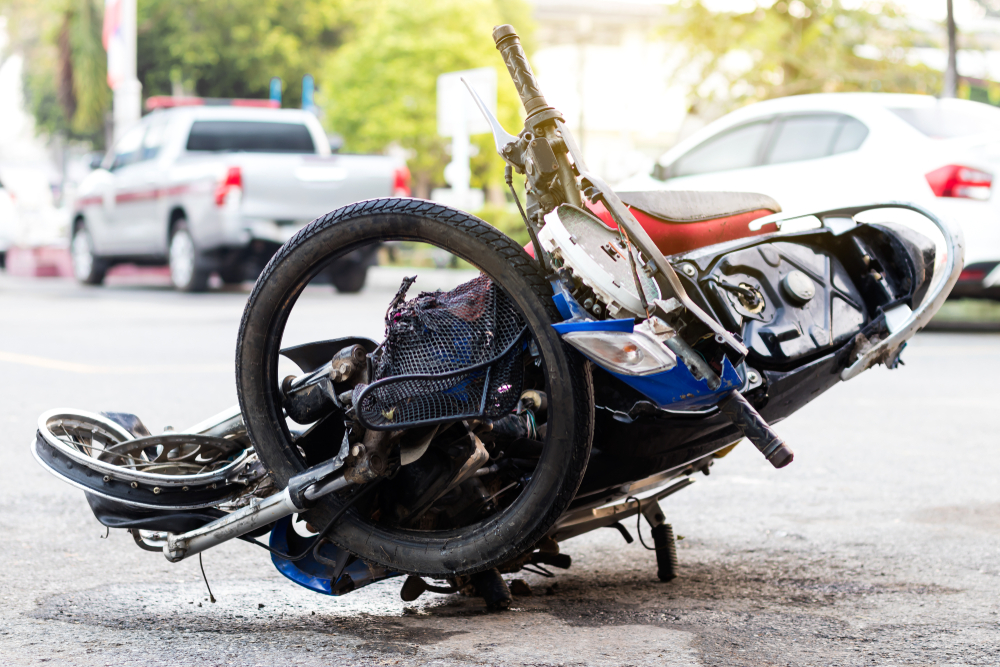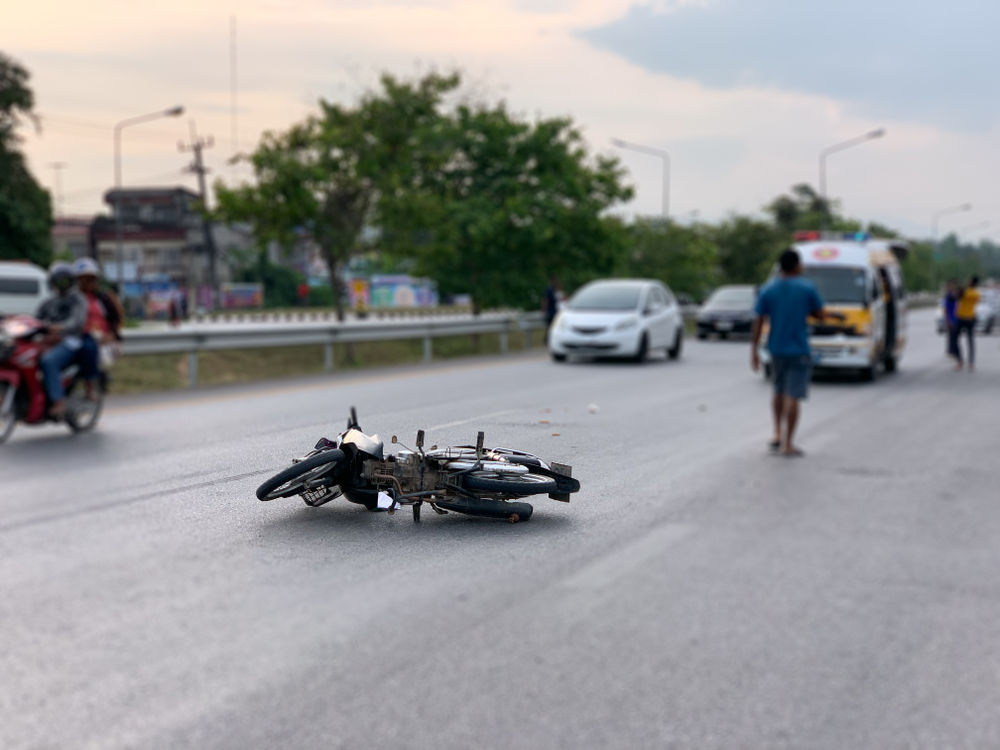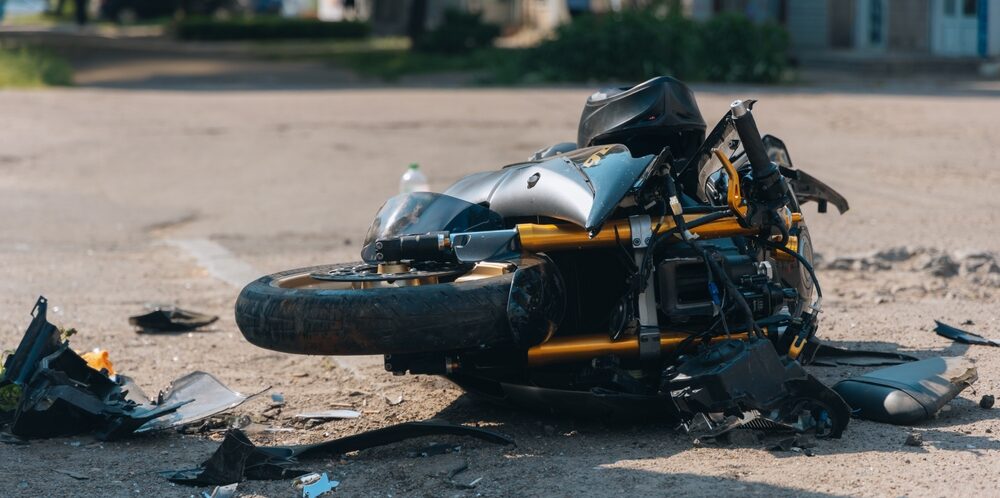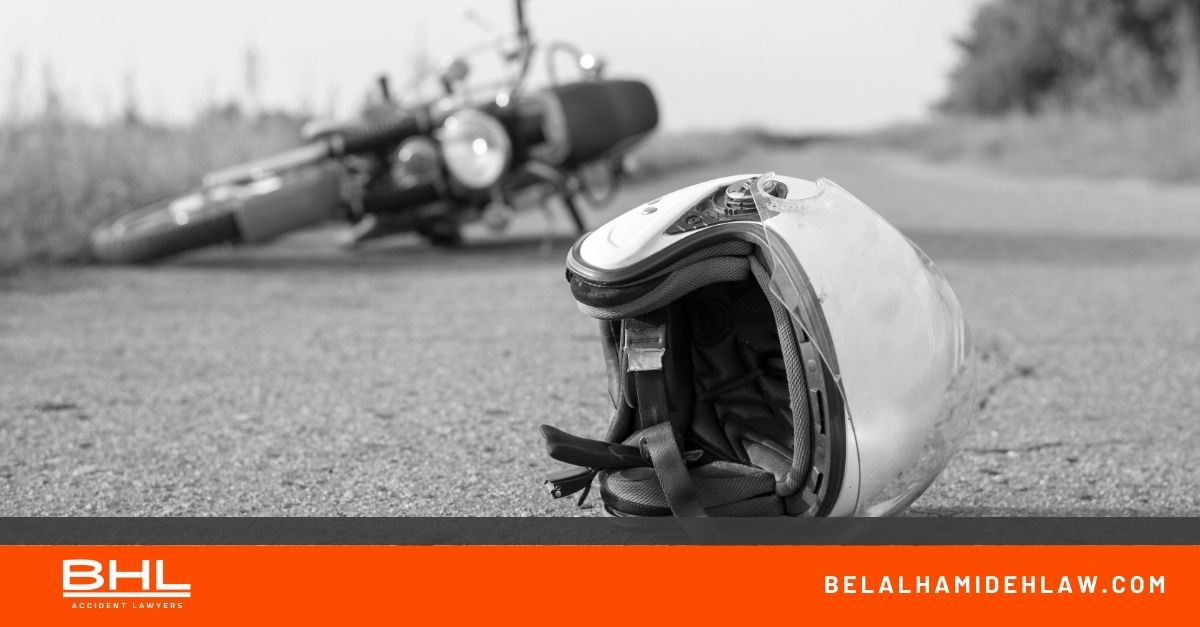Yes. Unfortunately, you can get PTSD (Post-Traumatic Stress Disorder) from being in an accident involving a motorcycle. In fact, you don’t even need to have been involved in the accident. Some may develop PTSD simply from having witnessed a motorcycle accident .
Trauma affects different people in different ways. How one person responds to a motorcycle accident will differ greatly from another. Indeed, PTSD itself can affect victims differently. For example, you may experience insomnia, anxiety, even nightmares, stress, and worse just from the accident.
If your motorcycle accident was the fault of another person, we can help you to recover compensation for PTSD and more that you’re dealing with as a direct result of the accident. To see how we can help, schedule a free case evaluation with experienced motorcycle accident lawyer Belal Hamideh through our site or by calling.

How an Experienced Motorcycle Accident Attorney Can Assist You
No matter if you were behind the handlebars or simply a passenger, experienced motorcycle accident attorney Belal Hamideh has the knowledge and skills to support you in claiming every bit of compensation you’re entitled to, based on the hardship you’ve faced.
Riding a motorcycle can offer unparalleled excitement, but it’s not without its risks. The severity of injuries sustained in a motorcycle accident often far surpasses those of other vehicular incidents, potentially resulting in grave trauma or even loss of life for you or your loved ones. In California, over 15% of all vehicular accident fatalities result from motorcycle accidents.

The financial implications of a motorcycle accident are immense and can quickly add up to millions. Your medical expenses may include rehabilitation, long-term care, and work reduction. You might also be coping with pain, suffering, and more. Belal Hamideh is here to help. Feel free to set up a free consultation with our team to explore your options for claiming deserved compensation.
Is it Beneficial to Engage a Motorcycle Accident Lawyer?
Absolutely. Engaging an experienced California motorcycle accident attorney is invaluable. A capable lawyer will fiercely safeguard your interests and legal rights while striving to secure maximum compensation for your claim.

An attorney with a rich history of handling motorcycle accident cases knows the ins and outs of evaluating your case to ensure you receive all due compensation. They are familiar with all procedural deadlines, from filing a lawsuit to submitting evidence, and will always prioritize your interests. They can negotiate your medical bills to the lowest feasible amount, compile police/traffic reports, and handle myriad other tasks so you can focus on your recovery.
In addition, a skilled motorcycle accident attorney knows how to navigate insurance claims. They grasp the intricacies of your policies, how they apply to your claim, the strategies insurance companies employ, and how to ensure you receive every penny you’re entitled to from the insurance company, whether through a settlement or court. Engaging the right attorney can provide substantial benefits.
What Kind of Remuneration Can I Get for My Motorcycle Incident?
In California, you are entitled to compensation for both your economic and non-economic damages as part of your accident claim. Economic damages include expenses related to your injury, like medical costs, lost income, motorcycle repair or replacement. In more severe cases, such damages may also cover rehabilitation services, future medical treatments, accommodation modifications, and so on.

Non-economic damages cater to the emotional and psychological impact of your accident – pain suffered, emotional distress, and the overall life changes you’ve had to endure. This could include “Loss of Consortium”, which accounts for the loss of a spouse, or “Loss of enjoyment of life”, for the inability to partake in pre-accident activities. Our firm is dedicated to ensuring you receive the compensation you deserve.
Who Can I Legally Pursue for My Motorcycle Incident?
The individual responsible for your accident can be sued. However, filing a lawsuit is merely the starting point. You also have to prove that the other driver’s negligence led to the accident and caused your damages.
To build a solid negligence case, your lawyer will help you provide evidence for four vital components. Firstly, the defendant had a “duty of care” towards you and other drivers to operate their vehicle safely. Secondly, you must demonstrate that the defendant breached this duty. Thirdly, you need to connect this breach to your accident. Lastly, you need to confirm that you sustained damages as a direct result of the accident. A seasoned lawyer can effectively demonstrate these components.
How Long will My Motorcycle Incident Claim Take to Settle?
Every accident is unique, thus claim durations vary. Some of our clients have seen settlements in a few weeks, but others have endured longer processes, including trials. Our team works tirelessly to fight for those who have been wronged in accidents like yours. The earlier you engage an attorney, the sooner we can start working on ensuring you get what you deserve.
Typical Motorcycle Accident Scenarios
Motorcycle accidents frequently involve collisions with larger vehicles. This tends to occur regularly in California due to its busy traffic environment. With the presence of the Port of California, one of the globe’s bustling cargo ports, numerous large vehicles like semi-trucks traverse the city daily. Add the approximately 900,000 vehicles owned by city dwellers, the risk factors for motorcyclists increase exponentially.
Driving under the influence is, sadly, the primary cause of motorcycle accidents. It is implicated in about ¼ of fatal motorcycle incidents. Other common culprits include high speed, lack of biker/driver experience, careless/distracted driving, and lane splitting among others. Still, several factors beyond the motorcyclist’s control contribute to the accidents such as faulty motorcycles, unsafe roads, impaired visibility, and more.
Should you be involved in a motorcycle accident, injuries often sustained include fractures, whiplash, harsh road rash burns, even TBI (traumatic brain injuries), spinal cord damage, and various degrees of paralysis. Regardless of the type of injury incurred, our team is here to assist you.
Steps to Take Post-Motorcycle Accident
In the aftermath of an accident, you may experience a surge of adrenaline, shock, and confusion. Here’s a guide on what to do next:
Prioritize safety. Endeavor to get out of danger and seek immediate medical attention even if you believe you’re unharmed.
Alert the police. It’s crucial that a police report is filed for your personal injury claim.
Collect Contact Information. Obtain names, contact numbers, licenses, addresses, insurance details, and vehicle descriptions from all parties involved.
Document the scene. If possible, take photographs of your injuries and the accident scene.
Avoid admitting fault. It’s unnecessary for you to accept responsibility at the accident scene.
Engage a seasoned attorney. We’re here to navigate the legal process with you every step of the way.
What If I Didn’t Use My Helmet?
It’s essential to always have your helmet on when riding a motorcycle, as clearly stated by California’s law. This law insists that all motorcycle riders and their passengers must wear helmets. Failing to wear a helmet during a motorcycle accident might lead to you being held partially culpable for your injuries.
Nevertheless, California operates under “comparative negligence state.” This implies that, despite not wearing a helmet during the accident, you can still seek and recover recompense for your pain, suffering, and injuries. We have a successful track record in aiding clients in similar situations.
What If I’m Uninsured?
Even if you’re uninsured yet it wasn’t your fault you had the accident, you’re still entitled to compensation for your injuries. However, your recompense might be considerably diminished because of the absence of liability coverage on your part.
If you’re involved in a motorcycle accident without being insured, even if you’re not at fault, you’ll face penalties for not having insurance, as all California drivers are required to have liability insurance.
Specifically, your penalty would involve a restriction on your ability to seek recompense for your pain and suffering, which are non-economic damages. Your quest for compensation would then apply solely to your economic damages. Nevertheless, we can assist you in obtaining the highest possible amount.
Engage a Reliable California Motorcycle Accident Lawyer
Motorcycle accident attorney Belal Hamideh has a history of assisting people who have been injured in motorcycle accidents for a considerable period. He is ready to utilize his experience and expertise to ensure you win your case. Our fee system operates such that you don’t have to pay until after the case has been won.
It’s quite normal to be hesitant about contacting a lawyer following your accident. However, the sooner you do it, the better your chances are at obtaining maximum compensation. You have a two-year window from the time of the accident to file a lawsuit for your injuries. Working on it sooner means receiving your compensation quicker. We’re ever ready to assist you so don’t wait until it’s too late.
California Motorcycle Laws
These laws may pertain to your situation. If you have further questions, don’t hesitate to reach out to Belal.
2009 California Vehicle Code – Section 27800-27803 :: Article 7. Motorcycles
VEHICLE CODE
SECTION 27800-27803
- It is unlawful for a driver of a motorcycle or a motorized
bicycle to carry any other person thereon, except on a seat securely
fastened to the machine at the rear of the driver and provided with
footrests, or in a sidecar attached to a motorcycle and designed for
the purpose of carrying a passenger. Every passenger on a motorcycle
or a motorized bicycle shall keep his feet on the footrests while
such vehicle is in motion.
- A person shall not drive a two-wheel motorcycle that is
equipped with either of the following:
(a) A seat so positioned that the driver, when sitting astride the
seat, cannot reach the ground with his or her feet.
(b) Handlebars so positioned that the hands of the driver, when
upon the grips, are more than six inches above his or her shoulder
height when sitting astride the seat.
- (a) The department may adopt reasonable regulations
establishing specifications and standards for safety helmets offered
for sale, or sold, for use by drivers and passengers of motorcycles
and motorized bicycles as it determines are necessary for the safety
of those drivers and passengers. The regulations shall include, but
are not limited to, the requirements imposed by Federal Motor Vehicle
Safety Standard No. 218 (49 C.F.R. Sec. 571.218) and may include
compliance with that federal standard by incorporation of its
requirements by reference. Each helmet sold or offered for sale for
use by drivers and passengers of motorcycles and motorized bicycles
shall be conspicuously labeled in accordance with the federal
standard which shall constitute the manufacturer’s certification that
the helmet conforms to the applicable federal motor vehicle safety
standards.
(b) No person shall sell, or offer for sale, for use by a driver
or passenger of a motorcycle or motorized bicycle any safety helmet
which is not of a type meeting requirements established by the
department.
- (a) A driver and any passenger shall wear a safety helmet
meeting requirements established pursuant to Section 27802 when
riding on a motorcycle, motor-driven cycle, or motorized bicycle.
(b) It is unlawful to operate a motorcycle, motor-driven cycle, or
motorized bicycle if the driver or any passenger is not wearing a
safety helmet as required by subdivision (a).
(c) It is unlawful to ride as a passenger on a motorcycle,
motor-driven cycles, or motorized bicycle if the driver or any
passenger is not wearing a safety helmet as required by subdivision
(a).
(d) This section applies to persons who are riding on motorcycles,
motor-driven cycles, or motorized bicycles operated on the highways.
(e) For the purposes of this section, “wear a safety helmet” or
“wearing a safety helmet” means having a safety helmet meeting the
requirements of Section 27802 on the person’s head that is fastened
with the helmet straps and that is of a size that fits the wearing
person’s head securely without excessive lateral or vertical
movement.
(f) This section does not apply to a person operating, or riding
as a passenger in, a fully enclosed three-wheeled motor vehicle that
is not less than seven feet in length and not less than four feet in
width, and has an unladen weight of 900 pounds or more, if the
vehicle meets or exceeds all of the requirements of this code, the
Federal Motor Vehicle Safety Standards, and the rules and regulations
adopted by the United States Department of Transportation and the
National Highway Traffic Safety Administration.
(g) In enacting this section, it is the intent of the Legislature
to ensure that all persons are provided with an additional safety
benefit while operating or riding a motorcycle, motor-driven cycle,
or motorized bicycle.
2023 California Code
Vehicle Code – VEH
DIVISION 12 – EQUIPMENT OF VEHICLES
CHAPTER 5 – Other Equipment
ARTICLE 7 – Motorcycles
Section 27803.
- (a) A driver and any passenger shall wear a safety helmet meeting requirements established pursuant to Section 27802 when riding on a motorcycle, motor-driven cycle, or motorized bicycle.
(b) It is unlawful to operate a motorcycle, motor-driven cycle, or motorized bicycle if the driver or any passenger is not wearing a safety helmet as required by subdivision (a).
(c) It is unlawful to ride as a passenger on a motorcycle, motor-driven cycles, or motorized bicycle if the driver or any passenger is not wearing a safety helmet as required by subdivision (a).
(d) This section applies to persons who are riding on motorcycles, motor-driven cycles, or motorized bicycles operated on the highways.
(e) For the purposes of this section, “wear a safety helmet” or “wearing a safety helmet” means having a safety helmet meeting the requirements of Section 27802 on the person’s head that is fastened with the helmet straps and that is of a size that fits the wearing person’s head securely without excessive lateral or vertical movement.
(f) This section does not apply to a person operating, or riding as a passenger in, a fully enclosed three-wheeled motor vehicle that is not less than seven feet in length and not less than four feet in width, and has an unladen weight of 900 pounds or more, if the vehicle meets or exceeds all of the requirements of this code, the Federal Motor Vehicle Safety Standards, and the rules and regulations adopted by the United States Department of Transportation and the National Highway Traffic Safety Administration.
(g) In enacting this section, it is the intent of the Legislature to ensure that all persons are provided with an additional safety benefit while operating or riding a motorcycle, motor-driven cycle, or motorized bicycle.
(Amended by Stats. 1997, Ch. 710, Sec. 4. Effective January 1, 1998.)
